 |
 |
 |
 |
 |
 |
 |
 |
 |
 |
 |
 |
 |
 |
 |
 |
 |
 |
 |
 |
 |
 |
 |
 |
 |
 |
 |
 |
 |
 |
 |
 |
 |
 |
 |
 |
 |
 |
 |
 |
 |
 |
 |
 |
 |
 |
 |
 |
 |
 |
 |
 |
 |
 |
 |
 |
 |
 |
 |
 |
 |
 |
 |
 |
 |
 |
 |
 |
 |
 |
 |
 |
 |
 |
 |
 |
 |
 |
 |
 |
 |
 |
 |
 |
 |
 |
 |
 |
 |
 |
 |
 |
 |
 |
 |
 |
 |
 |
 |
 |
 |
 |
 |
 |
 |
 |
 |
 |
 |
 |
 |
 |
 |
 |
 |
 |
 |
 |
|
Blue Marlin, Bluefin Tuna, Swordfish,
White Marlin, Large Sharks and Sailfish
-
Severity of Atlantic Population Declines, the Causes
and What Needs to be Done |
|
|
Current
Actions we are Taking
|
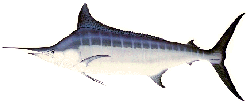 |
|
|
 |
|
|
|
 |
|
|
|
|
|
|
 |
|
|
 |
|
|
|
 |
|
|
|
|
|
|
|
|
|
|
Headed for Extinction? |
|
|
|
Are the world's most majestic marine game fish - bluefin tuna, swordfish,
marlin, sailfish and sharks - in real danger of disappearing forever? |
|
|
|
With record catches being recorded by many international billfish tournaments, is it possible that billfish and other top big game species could be in danger of disappearing completely?� For example, the March 1999 International La Guaira Billfish Shootout in Venezuela, held during the peak of their blue marlin season, set a record with a total of 256 blue marlin, 46 sailfish, 13 white marlin and four spearfish released by 118 anglers fishing on 40 boats.� It broke the all-time tournament record of 190 blue marlin, set a decade ago at the Club Nautico de San Juan's International Billfish Tournament in Puerto Rico.� (The 2000 Shootout, held in September during the peak of their white marlin season, produced 343 white marlin releases and 16 blues.)� Could the situation not look brighter? |
|
|
|
50
YEARS OF DECLINE |
|
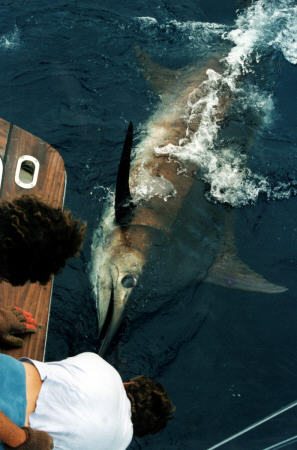 |
|
|
|
|
However, if you look at the bigger picture and consider the scientific
evidence developed during the last 50 years, a disturbing picture emerges. Decimation of the Atlantic Ocean's premiere game fish in just the last three decades has been nothing short of astounding!� Subsequent pages for each major species present this chilling evidence species-by-species.� Look particularly at the population trend lines for the last 5-10 years and where they are headed.�
Could we actually lose the magnificent marlin such as that pictured at right?�� We just can't let it happen.
Although it is not as well studied and documented, the same decimation of the great pelagic species is also occurring on a massive scale throughout the Pacific and the world's oceans, generally.
Drs. Ransom Myers and Boris Worm and their colleagues at Dalhousie
University have documented a 90%
decline in large marine species since worldwide industrial-scale fishing
began about 1960.� Today's "hot spots" for the big game fish may actually be the last refuges for these species.� If so, we had better think about their protection from excessive industrial-scale fishing which has been so well documented for the Atlantic. |
|
|
|
|
|
Purpose of this Webpage -
Portray the Severity of the Problem |
|
|
|
|
|
The purpose of this web page and its links to each species
(below) is to allow the big game fishing community to understand the severity of the problem using the Atlantic experience as an example.� It summarizes the scientific community's understanding of the population status of the most important big game species of the Atlantic Ocean - bluefin tuna, swordfish, blue marlin, white marlin, sailfish and sharks.� It is based on scientific reports issued by the International Commission for the Conservation of Atlantic Tunas (ICCAT), which since its formation in 1969, has been responsible for regulating all fishing for tunas and tuna-like fishes of the Atlantic Ocean.� ICCAT is composed of
48 member nations.� Its stated management objective is to produce the maximum catch on a sustainable basis, or as fishery scientists refer to it, the maximum sustainable yield (MSY).
In this, ICCAT has failed miserably. |
|
|
|
|
|
|
World record-size (estimated at 1,400 lbs.) Atlantic blue marlin being revived for release in the interest of conservation following its capture in the Azores by angler, Peter Ganz and Capt. Joseph Franck.� (Photo, P. Ganz) |
|
|
|
|
|
Population Status of the Atlantic Billfish, Swordfish, Tunas and Sharks |
|
|
|
The situation described on these pages is treated in detail in a new article by Chambers entitled
"Going, Going, Gone." It was published in the Jan/Feb 2000 issue of The Big Game Fishing Journal.� (The full article can be found HERE.)� Copies of the Big Game Fishing Journal are available from Journal Publications by calling 800-827-4468 or by email to [email protected].
The basic situation is also discussed in detail in a 1998 report that Chambers and Associates produced for the Recreational Fishing Alliance (RFA) entitled "Rebuilding North Atlantic Swordfish, a Report for the U.S. Congress and the Administration."��
While supplies last, copies are available without charge from RFA. |
|
|
|
According to ICCAT's scientific advisory committees, the stocks of most Atlantic highly migratory species that it purports to manage have declined dramatically from healthy population levels of about two times the biomass needed to produce the maximum sustainable yield (MSY), which existed before longlining was introduced in the U.S. in 1961, to only small percentages of MSY now or at the time of the most recent stock assessment (latest
year of reliable catch data noted in parentheses), as follows: |
|
|
|
% Decline |
|
% of MSY |
|
|
Stock (at the end of) |
|
|
|
|
|
|
|
|
97+ |
|
|
|
12 |
|
|
Western Atlantic bluefin tuna (2009) |
|
|
|
|
|
|
|
|
|
|
4 |
|
|
98 |
|
|
|
Atlantic white marlin (2007) |
|
|
|
|
|
|
|
20 |
|
|
90 |
|
|
|
Atlantic blue marlin (2007) |
|
|
|
|
|
|
|
|
|
|
35 |
|
|
70 |
|
|
|
Atlantic bigeye tuna (2008) |
|
|
|
|
|
|
|
64? |
|
65? |
|
|
North Atlantic swordfish (1999) |
|
|
|
|
|
|
|
47? |
|
|
75? |
|
|
|
Western Atlantic sailfish (2007) |
|
|
|
|
|
|
|
|
|
|
50-80 |
|
30-36 |
|
|
Large coastal sharks |
|
|
|
|
|
|
|
|
For a detailed description of the population trend of any stock listed above, click on its name. |
|
|
|
Blue marlin - at 20% of their pre-longlining abundance (40% of their sustainable yield level, indicated by the horizontal dotted line) - appear to be only about 10 years from extinction. |
|
|
Bluefin tuna have declined to
less than 3% of their estimated pre-longlining abundance level (and less
than 12% of
their sustainable yield level - the dotted line). They appear to be poised at the brink of extinction (the zero line). |
|
White marlin have
apparently declined to 2% of their pre-longlining abundance (4% of their sustainable yield level - the dotted line). They appear to be less than 5 years from extinction. |
|
|
|
|
|
|
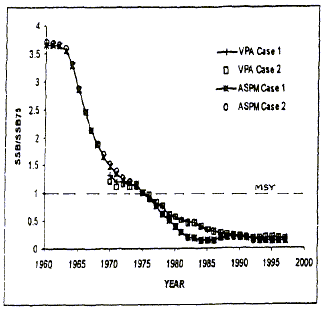 |
|
|
|
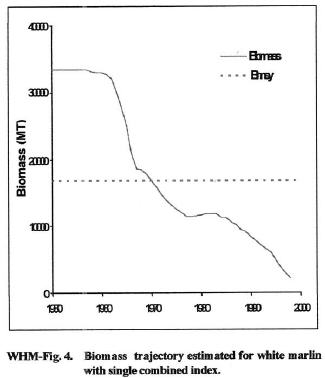 |
|
|
|
|
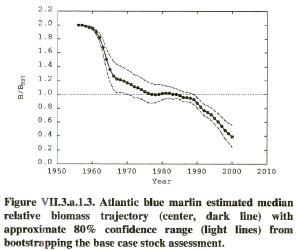 |
|
|
|
|
|
|
|
|
WHAT'S CAUSING THESE SEVERE POPULATION DECLINES? |
|
|
|
The primary cause of this decimation of the Atlantic Ocean's greatest game fish has been a 30-year absence of proper stewardship by those national and international governmental bodies which are responsible for managing the fishery and conserving the resource.� The U.S. federal agency responsible for stewardship of the nation's marine fishery resources is the National Marine Fisheries Service (NMFS).� The International Commission for the Conservation of Atlantic Tunas (ICCAT) is responsible for the conservation and management of tunas and tuna-like fishes of the Atlantic Ocean.� After hearing advice from its scientific advisory committees at its annual meeting in November, the Commission sets catch limits for its
48 member countries and is responsible for enforcing compliance.� However, as evidenced by the population declines noted above, throughout its existence, ICCAT has succeeded only in thoroughly documenting the demise of all the stocks for which it has claimed management authority.
The primary instrument of this destruction of the world's greatest game fish is unrestrained use of non-selective gear, in particular longlines, purse seines and gillnets.� Industrial-scale fishing operations conducted throughout the world's oceans employ these destructive and indiscriminate gear types primarily to catch swordfish and tunas.� But drift or pelagic longlines - averaging over 25 miles in length and armed with hundreds or even thousands of hooks - and drift gillnets also accidentally capture and kill much greater numbers of unmarketable juveniles, non-target fish and other wildlife including marine mammals, sea turtles and marine birds.� The extent of this bycatch and bykill, since more than half of the animals unlucky enough to have been caught are already dead when they reach the vessel, is larger than the number of target animals caught (ask RFA for its Report to Congress and the Administration entitled Rebuilding Swordfish).� And juveniles of target species (swordfish) that are too small to sell legally (under 41 lb) routinely make up 40-50% of the swordfish caught.� All of these are either dead already or die soon
thereafter.� The U.S. prohibits its commercial vessels from keeping Atlantic marlin and Atlantic sailfish, which must be released. (30% of the white marlin and 25% of the blue marlin are already dead when they reach the longline vessel.)�
However, billfish are routinely retained by all other countries fishing the high seas and even by U.S. vessels fishing in the Pacific. Pictured here (1, 2, 3, and 4) are 1,000-lb. blue marlin captured by local gillneters probably as these huge females aggregated to spawn off Salinas,
Ecuador. (Photo courtesy Fernando Mata). Pictured here (Pinas Bay massacre) are a large number of sailfish captured in one set by the Equadoran-flaged but U.S. owned tuna purse seiner, Betty C, off Pinas Bay, Panama - the site of Zane Grey Reef, a "Marine Protected Area" which has produced scores of IGFA world record catches. Note how this "massacre" has turned the water red with their blood. (Photo courtesy Luis L�pez Alfaro and Mike Foster). In another set by the Betty C witnessed by angler Cleofe Rubi (also pictured and described in "Marlin" Magazine, pg.14, Sept 2003) was estimated to have killed 500 sailfish.
|
|
|
|
Unmanageable Gear |
|
|
|
These non-selective gear types - particularly longlines and gillnets - are, quite simply, unmanageable.� They cannot be set to avoid catching and killing large numbers of non-target animals.� Excessive bykill is an unavoidable byproduct of fishing with drift longlines and with gillnets. |
|
|
|
The situation is examined in a 1998 report from the National Coalition for Marine Conservation (NCMC) entitled "Ocean Roulette, Conserving Swordfish, Sharks, and other Threatened Pelagic Fish in Longline-Infested Waters," which presents the results of a two-year study of the longline industry.� Its conclusion:� "Drift, or pelagic, longlines are incompatible with effective management and our national goal of sustainable fisheries.� The use of longlines must be severely curtailed." |
|
|
|
These fisheries are public resources that must be restored and sustained at healthy levels for the benefit of all, not just those who continue to profit by their extermination. However, NMFS has failed repeatedly to provide effective stewardship for these resources.� We have seen that these federal fishery managers respond only to political pressure, and until now, usually only to allow continued commercial exploitation.� Accordingly, we are convinced this political problem requires a political solution. |
|
|
|
"Recovery of the world's severely overfished swordfish, billfish and sharks cannot be achieved without removing the multi-mile, multi-hook longlines and gillnets from the water." |
|
|
|
Ken Hinman,� President of NCMC |
|
|
|
|
|
|
|
MORE PAGES:
Atlantic Population Declines
Swordfish, Blue Marlin,
White Marlin,
Sailfish,
Bluefin Tuna,
Bigeye Tuna,
Large Sharks
Daily "Kill-o-Meter"
Endangered Species Act
White Marlin
ESA Listing Petition
Bluefin Tuna ESA Listing Petition
Critical Habitat
Maps
- White Marlin, Blue Marlin
Recommended Longline
Closure Areas
Articles on Atlantic Big Game Fish and Fishing
Overview
Photos of Big Game Fish
(Many World Records)
Index
Proposed Longline Bills in Congress
Will They Work?
Spawning, Nursery and Feeding Area Maps
Swordfish, Bluefin Tuna, Blue Marlin,
White Marlin, Sailfish
Jim Chambers
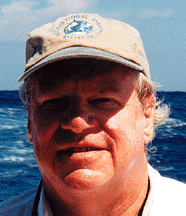
Chambers and Associates
Overview
List of All Pages on this Website
Home
|
|
|
"Going, Going ... Gone"� by Steve Goione
Image owned by NCMC (all rights reserved) |
|
|
|
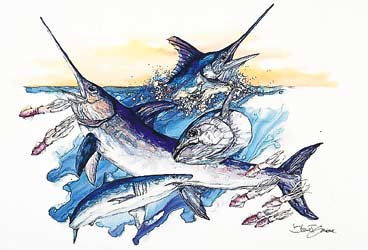 |
|
|
|
 |
|
|
Chambers and Associates
9814 Kensington Parkway
Kensington, Maryland 20895
(T) (301) 949-7778�� (Fax) (301) 949-3003 |
|
|
|
Blue Marlin Logo by Artist� Ron Pittard |
|
|
|












